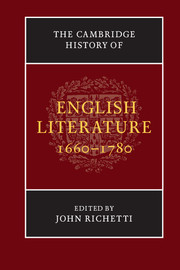Book contents
- Frontmatter
- Introduction
- PART I LITERARY PRODUCTION AND DISSEMINATION: CHANGING AUDIENCES AND EMERGING MEDIA
- 1 Publishing and bookselling 1660–1780
- 2 The social world of authorship 1660–1714
- 3 Popular entertainment and instruction, literary and dramatic: chapbooks, advice books, almanacs, ballads, farces, pantomimes, prints and shows
- 4 Novels on the market
- PART II LITERARY GENRES: ADAPTATION AND REFORMATION
- PART III LITERATURE AND INTELLECTUAL LIFE: THE PRODUCTION AND TRANSMISSION OF CULTURE
- PART IV LITERATURE AND SOCIAL AND INSTITUTIONAL CHANGE
- PART V LITERARY GENRES: TRANSFORMATION AND NEW FORMS OF EXPRESSIVENESS
- PART VI CONCLUSION
- Chronology
- Bibliographies
- Index
- References
4 - Novels on the market
from PART I - LITERARY PRODUCTION AND DISSEMINATION: CHANGING AUDIENCES AND EMERGING MEDIA
Published online by Cambridge University Press: 28 March 2008
- Frontmatter
- Introduction
- PART I LITERARY PRODUCTION AND DISSEMINATION: CHANGING AUDIENCES AND EMERGING MEDIA
- 1 Publishing and bookselling 1660–1780
- 2 The social world of authorship 1660–1714
- 3 Popular entertainment and instruction, literary and dramatic: chapbooks, advice books, almanacs, ballads, farces, pantomimes, prints and shows
- 4 Novels on the market
- PART II LITERARY GENRES: ADAPTATION AND REFORMATION
- PART III LITERATURE AND INTELLECTUAL LIFE: THE PRODUCTION AND TRANSMISSION OF CULTURE
- PART IV LITERATURE AND SOCIAL AND INSTITUTIONAL CHANGE
- PART V LITERARY GENRES: TRANSFORMATION AND NEW FORMS OF EXPRESSIVENESS
- PART VI CONCLUSION
- Chronology
- Bibliographies
- Index
- References
Summary
A new form of entertainment on the market: the novels of amorous intrigue
In the seventeenth century, first on the Continent and then in England, a modest new form of print entertainment appeared, but it seems to have taken its readers by storm. It was called ‘the novel’, and was viewed by contemporaries like Aphra Behn, William Congreve and Gottfried Wilhelm von Leibnitz as a symptom of a ‘novel’ turn in modern taste. This novel was short (compared to romance), written in prose rather than poetry, usually took sex and/or love as its topic and was usually set in the present rather than in some earlier ancient or legendary era. The most successful English writers of novels between 1683 and 1740 were Aphra Behn, Delariviere Manley and Eliza Haywood. Their success came from their development of a specific type of novel, the novel of amorous intrigue, designed to appeal to readers in the burgeoning English market in printed books. But these novels of the late seventeenth and early eighteenth century have been an embarrassment to most of the English literary history of the novel written since the late eighteenth century. Intent upon legitimatising the novel as a form of literature, literary histories of the novel written in the many years between Clara Reeve's Progress of Romance (1785) and Ian Watt's The Rise of the Novel (1957) have laboured to efface the centrality of the enormously popular novels of amorous intrigue. By doing so, most literary history has obscured the productive symbiosis between this early type of English fiction, and those narratives written by the three canonical authors usually installed in the position of the fathers of the English novel: Daniel Defoe, Samuel Richardson and Henry Fielding.
- Type
- Chapter
- Information
- The Cambridge History of English Literature, 1660–1780 , pp. 87 - 106Publisher: Cambridge University PressPrint publication year: 2005
References
- 2
- Cited by

